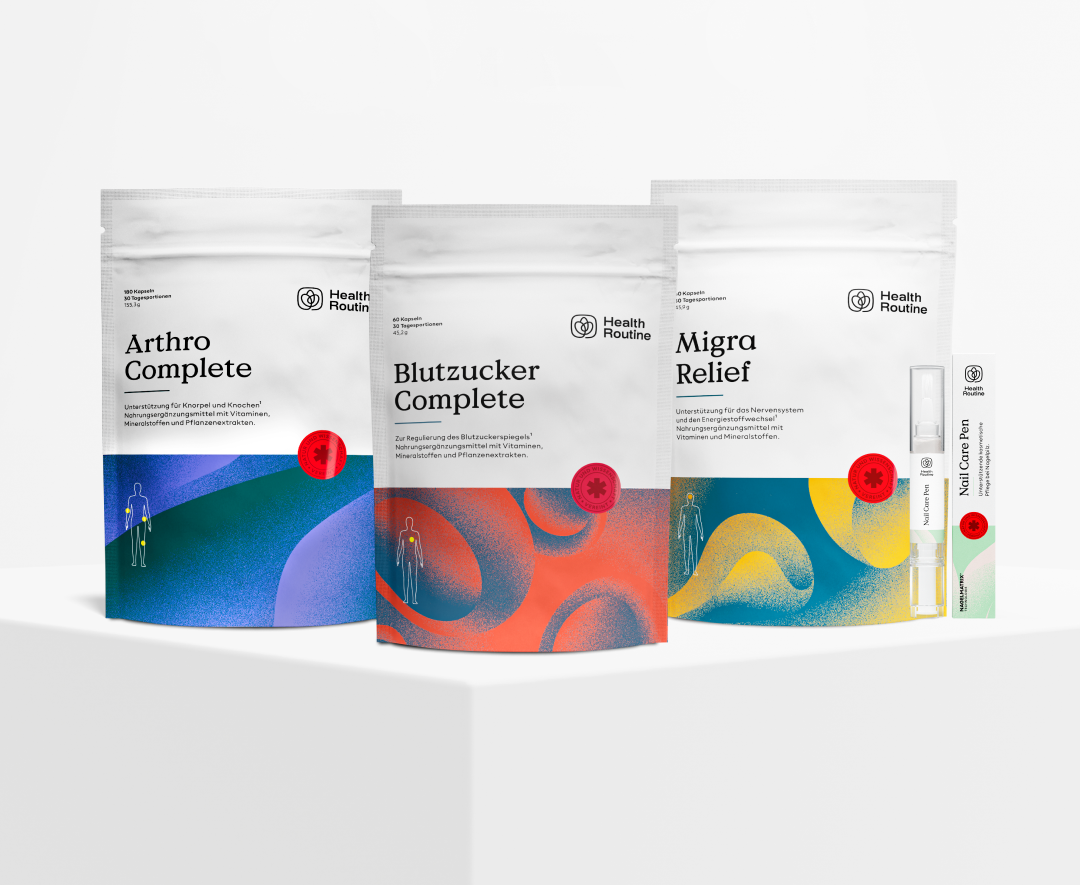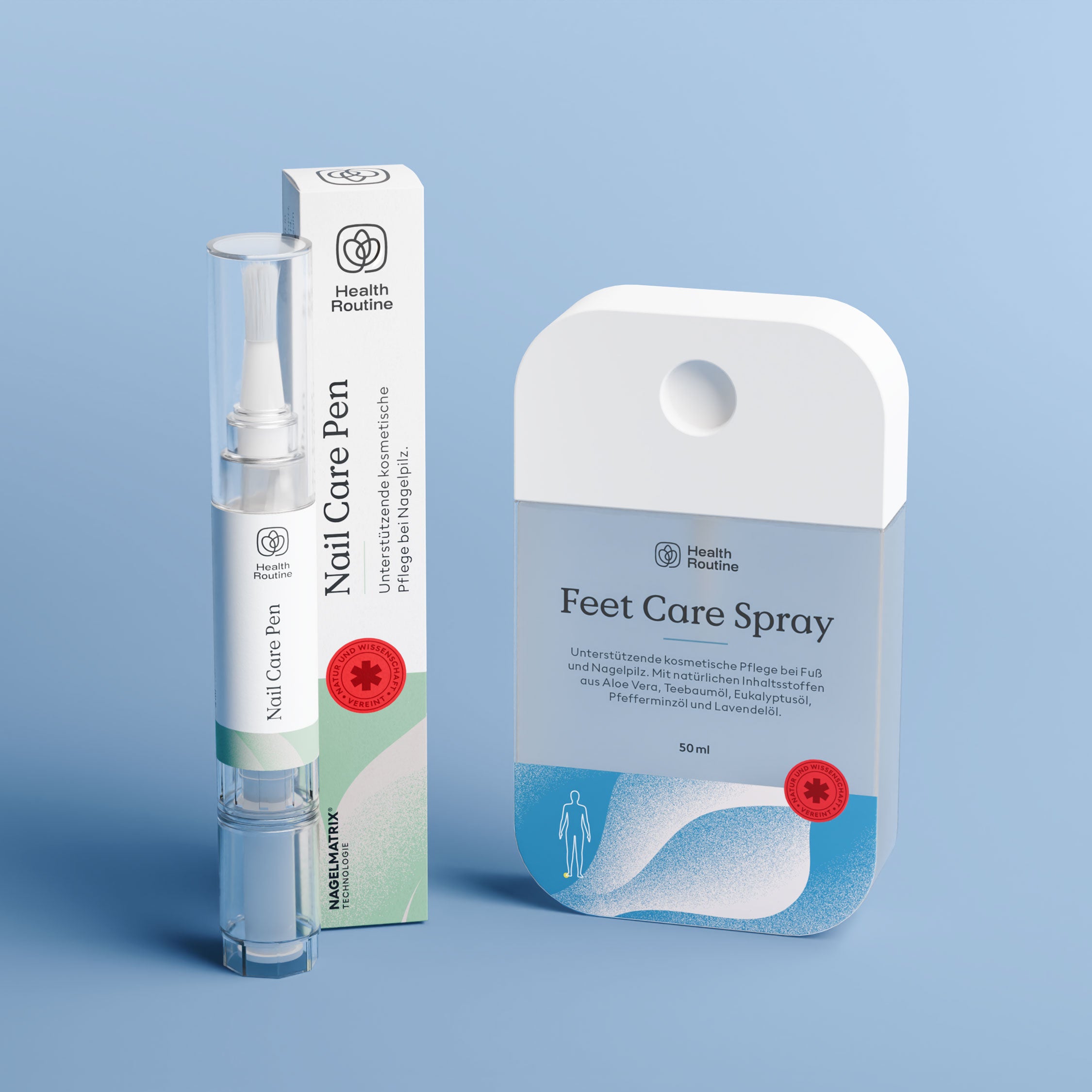The most important things at a glance:
-
Learn how nail changes can manifest themselves due to fungal infections.
-
Learn what measures can contribute to a well-groomed nail appearance.
-
Discover practical tips for everyday nail care.
Nail fungus – what’s behind it?
Nail fungus is an unpleasant condition that many of us would rather avoid. But just like an unwanted visitor who just won't leave, ignoring it is rarely the best strategy. Nail fungus , medically known as onychomycosis , is persistent but not invincible.
With the right knowledge and a suitable remedy, you can get rid of the unwanted nail fungus even without the longed-for secret tip and restore your nails to their healthy state.
In this guide, we will show you how to recognize nail fungus, how nail fungus is treated, and how long the treatment of nail fungus takes.

What exactly is nail fungus?
Nail fungus is an infection caused by various types of fungi. These fungus literally nest in your nails. Fungi love warm, moist environments —like the ones in your shoes, for example.
Nail fungus can affect both fingernails and toenails , although toenails are significantly more commonly affected. A fungal nail infection often begins as a white or yellow spot under the tip of your nail and can then spread.
Fungal infection leads to nail discoloration or thickening of the nail. In more severe cases, the nail may even fall off.
Which pathogens are responsible for nail fungus?
There are 3 main pathogen groups related to nail fungus:
-
Filamentous fungi: The dermatophyte usually occurs on a free part of the nail and in connection with the first nail changes.
-
Yeast fungus: This form of nail fungus rarely occurs on toenails. However, it is more common in fingernails.
- Mold: This form of fungal infection on nails is also more common on fingernails.

Recognizing nail fungus: Typical symptoms
Nail fungus can manifest itself in a variety of ways. It's important to recognize the symptoms early so that nail fungus treatment can begin as soon as possible.
Here are some typical signs that may indicate a fungal nail infection :
-
Discoloration: Your nail may become yellowish, greenish, or white. Nail discoloration is often the first visible sign of nail fungus.
-
Thickening: The nail may become thicker and change shape. It may also become irregular or wavy.
-
Brittleness: Brittle fingernails or toenails can also be a sign of nail fungus. If the nail fungus is left untreated, the nail edges may also detach.
-
Pain: Although nail fungus is often painless, in some cases it can cause pain or discomfort, especially when walking or wearing shoes.
- Unpleasant odor: In some cases, an infected nail may emit an unpleasant odor.
If you notice one or more of these symptoms, you may have nail fungus.
It's important that you don't delay and start treatment or consult a doctor as soon as possible to prevent the infection from spreading further.

Cuida también cosméticamente en caso de infección por hongos en las uñas
Hidrata y regenera
Protege y fortalece las uñas
How do you get nail fungus?
Nail fungus is a common condition , and there are many ways to become infected . The fungi that cause nail fungus are found everywhere in our environment—in the soil , on our skin , and in the air .
They thrive particularly well in warm, humid environments such as:
- swimming pools,
- Shower,
- Fitness studios
- and especially in the bathroom at home.
If you walk barefoot in such areas, the risk of infection increases many times over.
Other possible sources where nail fungus can develop are:
- shoes that are too tight
- sporting activities due to excessive shoe wear caused by fast movements
- diabetes
- genetic factors
- Injuries to the nail
- Rental shoes
- tail feet
Expert advice: It is important to know these risk factors and possible sources of nail fungus in order to take measures to prevent or treat it.
Treating nail fungus correctly
Nail fungus can be stubborn, but with the right treatment and a little patience, you can successfully combat it. There's no one-size-fits-all solution for nail fungus treatment, as it all depends on the severity of the infection.
But even without an insider tip, there are various remedies and methods against nail fungus:
- of treatments applied directly to the nail,
- to oral medications,
- and even surgical procedures.
Which treatment method is best for you depends not only on the severity of the infection but also on your general health.

Treating nail fungus with nail fungus varnish
Nail polish is a common method for treating nail fungus. It is applied directly to the infected nail and contains active ingredients that kill the fungus. Nail polish can be an effective method for combating nail fungus, especially in the early stages of the infection.
There are also various tinctures and sprays for nail fungus that work similarly to nail polish. They contain antifungal agents that kill the fungus and promote the growth of new, healthy nails.
Nail fungus treatment with ointments and creams
Ointments are another option for treating nail fungus. They contain antifungal agents that are applied directly to the infected nail. There are also special urea ointments that help soften the thickened nail, allowing the antifungal agents to penetrate more easily.
Nail Care Pen for the treatment of nail fungus
Another companion on the way to healthier nails can be the Nail Care Pen from Health Routine . This practical tool contains 100% natural ingredients , including
- Tea tree oil, which contributes to the antibacterial effect
- and aloe vera, which contributes to the elasticity of the nail bed.
Overall, the Nail Care Pen offers cosmetic care to accompany therapy for nail fungus and offers cosmetic support in reducing nail discoloration .
A major advantage is its quick and easy application ! Dosing is simpler and more precise than with a polish or ointment. It can also be conveniently carried in your bag. This allows you to perform your treatment anytime, anywhere.

Cuida también cosméticamente en caso de infección por hongos en las uñas
Hidrata y regenera
Protege y fortalece las uñas
Tablets against nail fungus
In more severe cases , oral medications may also be necessary to treat nail fungus. These medications work systemically to fight the fungus from within.
They are generally very effective , but can also have side effects . Oral medications for nail fungus should therefore only be used under medical supervision .
Laser treatment for nail fungus removal
Laser treatments are a newer method for treating nail fungus. They use light energy to kill the fungus without damaging the surrounding nail or skin. This method is primarily used when other treatments have failed.
Nail fungus treatment through surgery
In extreme cases , when the nail fungus is very advanced or other treatments are ineffective, it may be necessary to surgically remove the infected nail .
This allows the underlying fungus to be treated directly and creates space for a new, healthy nail to grow. However, surgery is one of the last options considered for treating nail fungus.
Is nail fungus dangerous?
Nail fungus is usually not life-threatening , but it can still cause significant discomfort and inconvenience . In addition to the cosmetic problems caused by discolored and thickened nails, nail fungus can also cause pain and discomfort.
This can be particularly unpleasant if the fungus affects the toenails and interferes with walking or wearing shoes.
In some cases, nail fungus can also cause difficulty gripping if the fingernails are affected. Furthermore, an untreated fungal nail infection can cause the nail to become deformed or fall off completely.
For people with a healthy immune system, nail fungus is usually more of an annoyance than a dangerous condition .
However, nail fungus can be more serious in people with a weakened immune system , such as the elderly or those with certain chronic diseases such as diabetes or HIV.
Therefore, it's important to take nail fungus seriously and treat it early . This way, you can avoid potential complications and also prevent yourself from infecting others.
What happens if you don't treat nail fungus?
"Does nail fungus go away on its own?" is certainly one of the most frequently asked questions. However, if nail fungus is left untreated , it can spread and infect other nails.
It can also cause permanent damage to your nails, causing them to permanently change their shape and growth. In severe cases, the fungus can also infect the surrounding tissue .
It's a common misconception that nail fungus goes away on its own. In fact, nail fungus requires targeted treatment to be completely cured.
How long does it take for nail fungus to go away?
The duration of nail fungus treatment can vary greatly and depends on various factors , such as
- the severity of the infection
- and the chosen treatment method.
However, it usually takes several weeks to months for the nail fungus to heal completely.
It's important to be patient and continue treatment consistently , even after symptoms have subsided . This way, you can ensure that the fungus is completely eliminated and doesn't return.
Preventing nail fungus: 5 tips
Nail fungus can be uncomfortable and impact the health of your nails, so it's a good idea to take steps to prevent it in the first place.
Fortunately, there are some simple steps you can follow to minimize your risk of fungal nail infection.

Here are five tips to prevent nail fungus:
-
Keep your feet dry: Fungi love moist environments, so it's important to keep your feet as dry as possible. Dry your feet thoroughly after showering or bathing, especially between the toes.
Also avoid wearing heavy, non-breathable shoes that make your feet sweat.
-
Wash and change socks: Always wear clean socks and change them regularly, especially after sweating. It's also a good idea to wear socks made from natural materials like cotton or wool.
These can absorb moisture better than synthetic materials.
-
Wear slippers: Communal showers and swimming pools are hotspots for fungal infections. Protect your feet by wearing slippers or flip-flops when using these areas.
-
Walk barefoot a lot: Walking barefoot allows your feet to breathe and reduces the moisture needed for fungi to grow. When safe and appropriate, take off your shoes and enjoy the feeling of freedom on your feet.
- Change your shoes: If possible, change your shoes daily to give them a chance to dry completely before wearing them again. This can be especially helpful if you tend to have sweaty feet.

Cuida también cosméticamente en caso de infección por hongos en las uñas
Hidrata y regenera
Protege y fortalece las uñas
Conclusion
Healthy and beautiful nails are aesthetically pleasing and make a good impression. Unfortunately, nail fungus can ruin that.
However, if you suffer from athlete's foot or nail fungus in general, this problem is not insurmountable. The key to healthy nails lies in perseverance and the willingness to take care of your own health.
The Health Routine Nail Care Pen can be your practical companion on this journey. With its convenient format, easy application, and natural ingredients, it's a powerful tool in your daily nail care arsenal.
So, take your health into your own hands and get to know the Nail Care Pen with the aim of making your nails healthy and strong.
FAQ
Can you treat athlete's foot and nail fungus at the same time?
Yes, it is entirely possible and even recommended to treat athlete's foot and nail fungus simultaneously. This helps prevent cross-contamination and thus re-infection—whether from the feet to the hands or vice versa.
Nail fungus won't go away: What to do?
If your nail fungus doesn't go away despite treatment, you should see a doctor. You may need stronger treatment, such as tablets or another medication.
In severe cases, it may also be helpful to have the affected nail surgically removed.
Is nail fungus actually contagious?
Yes, nail fungus is contagious. It can be spread from person to person, especially in humid environments like communal showers or swimming pools.
The fungus can also spread from one infected nail to other nails, so you should start treatment early.
Which doctor treats nail fungus?
The treatment of nail fungus is usually the responsibility of a dermatologist, a skin doctor. A dermatologist specializes in diseases of the
- Skin,
- Hair
- and nails and can determine the appropriate treatment for your nail fungus.
In some cases, a podiatrist, a foot health specialist, may also be helpful in treating nail fungus. If you're unsure who should treat your nail fungus, your primary care physician can refer you to an appropriate specialist.
Your medical advice
Our products are not intended to diagnose, treat, cure, or prevent any disease. The information provided in this article is for informational purposes only and is not intended as a substitute for advice from your physician or other healthcare professional.
Furthermore, our products are not a substitute for medications or other treatments prescribed by your doctor or healthcare provider. Regardless of the due care taken, no liability or warranty is assumed for the
- Accuracy,
- topicality,
- completeness
- and availability of the information provided.
No legal claims can be made for any damages potentially resulting from the use and application of this information. Liability claims of any kind are excluded.
🌿 Would you like to read more about nail care ?
- The importance of nutrition for healthy fingernails
- Grooves in the fingernails » All causes at a glance!
- How to file nails properly: Tips and tricks for beginners and professionals






